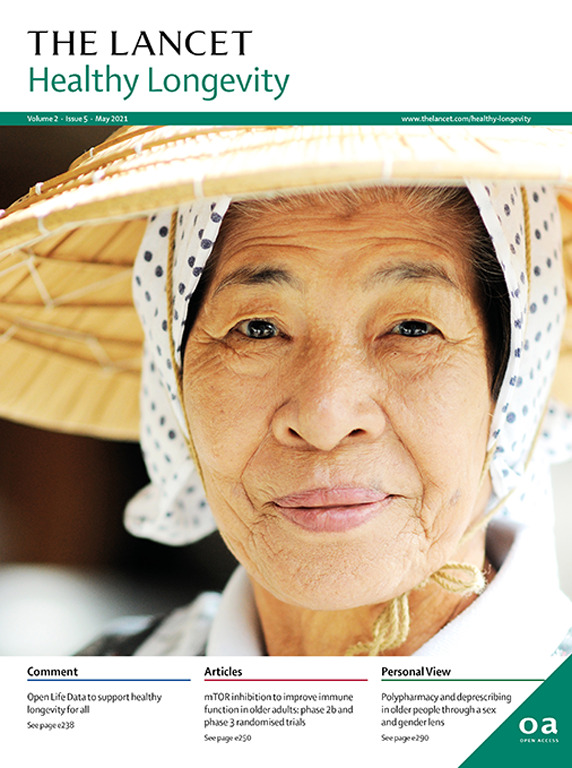Association between physical activity and sedentary behaviour and changes in intrinsic capacity in Spanish older adults (Seniors-ENRICA-2): a prospective population-based study
IF 14.6
Q1 GERIATRICS & GERONTOLOGY
引用次数: 0
Abstract
Background
Intrinsic capacity—the composite of all the physical and mental capacities of an individual—has been proposed by WHO as a marker of healthy ageing. However, the association of movement behaviours (physical activity and sedentary behaviour) with intrinsic capacity remains largely unexplored. We aimed to prospectively analyse the association of movement behaviours with intrinsic capacity in older adults.
Methods
The Seniors-ENRICA-2 prospective, population-based study included a cohort of male and female community-dwelling older adults aged 65–94 years living in Spain. Accelerometer-based levels of sedentary, light physical activity (LPA), and moderate-to-vigorous physical activity (MVPA) were assessed at baseline. An intrinsic capacity composite score (with higher scores indicating higher intrinsic capacity) was calculated at baseline and at two follow-up assessments across six domains: vitality (handgrip strength, appetite, and weight loss), cognition (Mini-Mental State Examination), psychological (Geriatric Depression Scale), locomotion (Short Physical Performance Battery), vision, and hearing.
Findings
Between Dec 2, 2015, and Nov 23, 2017, 3273 participants were recruited to the Seniors-ENRICA-2 study. 2477 (75·7%) of 3273 participants had complete data for movement behaviours and intrinsic capacity at baseline and were therefore included in the analyses. 1314 (53·0%) of 2477 participants were female and 1163 (47·0%) were male. 1463 (59·1%) of 2477 participants provided follow-up data over a median of 2·3 years (IQR 2·1 to 2·5) and 940 over 5·5 years (5·2 to 5·8). When analysed as a continuous variable, higher levels of MVPA (mean percentage change [MPC] per 15 min 0·63%, 95% CI 0·06 to 1·21), but not LPA (–0·39%,–0·85 to 0·07), were associated with improvements in intrinsic capacity during follow-up, whereas higher levels of sedentary behaviour were associated with declines in intrinsic capacity (–0·29%, –0·57 to –0·01). Analyses by tertiles of physical activity confirmed that the highest (MPC 4·83%, 95% CI 1·98 to 7·75) and intermediate (5·44%, 2·52 to 8·45) tertiles of MVPA were associated with improvements in intrinsic capacity compared with the lowest tertile. By contrast, compared with the highest tertile, the lowest (MPC 5·48%, 95% CI 2·88 to 8·02) and intermediate (5·73%, 3·16 to 8·22) tertiles of sedentary behaviour were associated with improvements in intrinsic capacity.
Interpretation
Sedentary behaviour was associated with a reduction of intrinsic capacity, and MVPA (but not LPA) was associated with an improvement in intrinsic capacity in older adults. Our findings support the importance of promoting physical activity and reducing sedentary behaviour for healthy ageing.
Funding
Instituto de Salud Carlos III, Spanish Ministry of Science and Innovation, French Agence Nationale de la Recherche, European Regional Development Fund/European Social Fund, Fondo de Investigaciones Sanitarias, the EU NextGenerationEU/Plan de Recuperación, and Transformación y Resiliencia.
西班牙老年人体力活动、久坐行为和内在能力变化之间的关联(senior - enrica -2):一项基于人群的前瞻性研究。
背景:内在能力——一个人的所有生理和心理能力的综合——已被世卫组织提出作为健康老龄化的标志。然而,运动行为(身体活动和久坐行为)与内在能力之间的关系在很大程度上仍未被探索。我们的目的是前瞻性地分析老年人运动行为与内在能力的关系。方法:senior - enrica -2前瞻性、基于人群的研究纳入了一组居住在西班牙的65-94岁社区老年人。以加速度计为基础的久坐、轻度体力活动(LPA)和中度至剧烈体力活动(MVPA)水平在基线时进行评估。内在能力综合评分(分数越高表明内在能力越强)在基线和两次后续评估中计算,涉及六个领域:活力(握力、食欲和体重减轻)、认知(迷你精神状态检查)、心理(老年抑郁量表)、运动(短体能表现电池)、视力和听力。研究结果:2015年12月2日至2017年11月23日,3273名参与者被招募到senior - enrica -2研究中。3273名参与者中有2477名(75.7%)在基线时具有完整的运动行为和内在能力数据,因此被纳入分析。2477名参与者中,女性1314人(53.0%),男性1163人(47.0%)。2477名参与者中有1463名(59.1%)提供了中位数为2.3年(IQR为2.1至2.5)的随访数据,940名提供了中位数为5.5年(5.2至5.8)的随访数据。当作为一个连续变量进行分析时,较高水平的MVPA(每15分钟平均百分比变化[MPC] 0.63%, 95% CI 0.06至1.21)与随访期间内在能力的改善相关,但LPA没有(- 0.39%,- 0.85至0.07),而较高水平的久坐行为与内在能力的下降相关(- 0.29%,- 0.57至- 0.01)。体力活动的分位数分析证实,与最低分位数相比,MVPA的最高分位数(MPC 4.83%, 95% CI 1.98 ~ 7.75)和中等分位数(5.44%,2.52 ~ 8.45)与内在能力的改善相关。相比之下,与最高分位数相比,最低分位数(MPC 5.48%, 95% CI 2.88至8.02)和中间分位数(5.73%,3.16至8.22)的久坐行为与内在能力的改善有关。解释:久坐行为与老年人内在能力的降低有关,而MVPA(而不是LPA)与内在能力的提高有关。我们的研究结果支持促进体育活动和减少久坐行为对健康老龄化的重要性。资助:卡洛斯三世研究所、西班牙科学与创新部、法国国家研究局、欧洲区域发展基金/欧洲社会基金、卫生调查基金会、欧盟下一代计划Recuperación和Transformación y Resiliencia。
本文章由计算机程序翻译,如有差异,请以英文原文为准。
求助全文
约1分钟内获得全文
求助全文
来源期刊

Lancet Healthy Longevity
GERIATRICS & GERONTOLOGY-
CiteScore
16.30
自引率
2.30%
发文量
192
审稿时长
12 weeks
期刊介绍:
The Lancet Healthy Longevity, a gold open-access journal, focuses on clinically-relevant longevity and healthy aging research. It covers early-stage clinical research on aging mechanisms, epidemiological studies, and societal research on changing populations. The journal includes clinical trials across disciplines, particularly in gerontology and age-specific clinical guidelines. In line with the Lancet family tradition, it advocates for the rights of all to healthy lives, emphasizing original research likely to impact clinical practice or thinking. Clinical and policy reviews also contribute to shaping the discourse in this rapidly growing discipline.
 求助内容:
求助内容: 应助结果提醒方式:
应助结果提醒方式:


